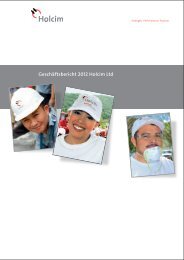Transocean Proxy Statement and 2010 Annual Report
Transocean Proxy Statement and 2010 Annual Report
Transocean Proxy Statement and 2010 Annual Report
Create successful ePaper yourself
Turn your PDF publications into a flip-book with our unique Google optimized e-Paper software.
TRANSOCEAN LTD. AND SUBSIDIARIES<br />
NOTES TO CONSOLIDATED FINANCIAL STATEMENTS — Continued<br />
Credit risk—Financial instruments that potentially subject us to concentrations of credit risk are primarily cash <strong>and</strong> cash<br />
equivalents, short-term investments <strong>and</strong> trade receivables. It is our practice to place our cash <strong>and</strong> cash equivalents in time deposits at<br />
commercial banks with high credit ratings or mutual funds, which invest exclusively in high quality money market instruments. We limit the<br />
amount of exposure to any one institution <strong>and</strong> do not believe we are exposed to any significant credit risk.<br />
We derive the majority of our revenue from services to international oil companies, government-owned <strong>and</strong><br />
government-controlled oil companies. Receivables are dispersed in various countries (see Note 22—Segments, Geographical Analysis<br />
<strong>and</strong> Major Customers). We maintain an allowance for doubtful accounts receivable based upon expected collectability <strong>and</strong> establish<br />
reserves for doubtful accounts on a case-by-case basis when we believe the required payment of specific amounts owed to us is unlikely<br />
to occur. Although we have encountered isolated credit concerns related to independent oil companies, we are not aware of any<br />
significant credit risks related to our customer base <strong>and</strong> do not generally require collateral or other security to support customer<br />
receivables.<br />
Labor agreements—We require highly skilled personnel to operate our drilling units. We conduct extensive personnel<br />
recruiting, training <strong>and</strong> safety programs. At December 31, <strong>2010</strong>, we had approximately 18,050 employees, including approximately<br />
1,950 persons engaged through contract labor providers. Some of our employees working in Angola, the U.K., Norway <strong>and</strong> Australia, are<br />
represented by, <strong>and</strong> some of our contracted labor work under, collective bargaining agreements. Many of these represented individuals<br />
are working under agreements that are subject to annual salary negotiation. These negotiations could result in higher personnel<br />
expenses, other increased costs or increased operational restrictions as the outcome of such negotiations apply to all offshore employees<br />
not just the union members.<br />
Additionally, the unions in the U.K. sought an interpretation of the application of the Working Time Regulations to the offshore<br />
sector. Although the Employment Tribunal endorsed the unions’ position that offshore workers are entitled to 28 days of annual leave, at<br />
the subsequent appeals to date, both the Employment Appeal Tribunal <strong>and</strong> the Court of Session have reversed the Employment Tribunal’s<br />
decision. However, the unions have intimated their intention to lodge a further appeal to the Supreme Court which may not be heard until<br />
the fourth quarter of 2011 or 2012.<br />
The application of the Working Time Regulations to the offshore sector could result in higher labor costs <strong>and</strong> could undermine<br />
our ability to obtain a sufficient number of skilled workers in the U.K. Legislation has been introduced in the U.S. Congress that could<br />
encourage additional unionization efforts in the U.S., as well as increase the chances that such efforts succeed. Additional unionization<br />
efforts, if successful, new collective bargaining agreements or work stoppages could materially increase our labor costs <strong>and</strong> operating<br />
restrictions.<br />
Note 21—Supplemental Cash Flow Information<br />
We include investments in highly liquid debt instruments with an original maturity of three months or less in cash <strong>and</strong> cash<br />
equivalents. In September 2008, The Reserve announced that certain funds, including The Reserve Primary Fund <strong>and</strong> The Reserve<br />
International Liquidity Fund Ltd. (together, the “Reserve Funds”), had lost the ability to maintain a net asset value of $1.00 per share due to<br />
losses in connection with the bankruptcy of Lehman Brothers Holdings, Inc. (“Lehman Holdings”). According to its public disclosures,<br />
The Reserve stopped processing redemption requests in order to develop an orderly plan of liquidation that would protect all of the funds’<br />
shareholders. At the time of The Reserve’s announcements, we had an aggregate investment of $408 million in the Reserve Funds. We<br />
collected $37 million, $296 million <strong>and</strong> $58 million from the Reserve Funds in the years ended December 31, <strong>2010</strong>, 2009 <strong>and</strong> 2008,<br />
respectively. As of December 31, <strong>2010</strong>, we had collected our total expected recoveries from the Reserve Funds, having recognized losses<br />
on impairment of $1 million <strong>and</strong> $16 million, recorded in other, net in the years ended December 31, <strong>2010</strong> <strong>and</strong> 2008, respectively. There<br />
was no loss on impairment for the year ended December 31, 2009.<br />
Net cash provided by (used in) operating activities attributable to the net change in operating assets <strong>and</strong> liabilities were<br />
composed of the following (in millions):<br />
Years ended December 31,<br />
<strong>2010</strong> 2009 2008<br />
Changes in operating assets <strong>and</strong> liabilities<br />
Decrease (increase) in accounts receivable $ 386 $ 504 $ (501 )<br />
Increase in other current assets (75 ) (50 ) (118 )<br />
Increase in other assets (40 ) (30 ) (8 )<br />
Increase (decrease) in accounts payable <strong>and</strong> other current liabilities 227 (60 ) 75<br />
Decrease in other long-term liabilities (52 ) (7 ) (43 )<br />
Change in income taxes receivable / payable, net (37 ) 77 274<br />
$ 409 $ 434 $ (321 )<br />
AR-115

















